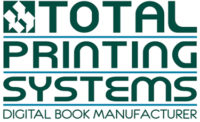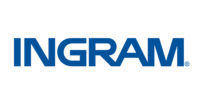PUBLISHED NOVEMBER/DECEMBER 2018
by Matt Baehr, Executive Director, Book Manufacturers' Institute --

Matt Baehr
As the executive director of the Book Manufacturers' Institute, I have seen some noteworthy ideas take hold, from experimentation on the production line, breakthroughs in inkjet printing hardware, and data analysis. What's new, and what's next?
It was 2007 when Amazon started selling the Kindle. Amid the excitement that consumers would be able to download books in seconds and have millions of titles available to them on demand,
The Economist published a story titled "The Book Is Dead." Many wondered: Would e-books disrupt and, ultimately, kill print books forever?

Needless to say, the book industry needed to change to cater to the needs and tastes of 21st-century readers. Since digital technology has pervaded all segments of the book industry ecosystem—from publisher workflows and consumer discovery, to automation in factories and the development of more accurate forecasting models—there have been countless ups and downs and twists and turns.
The good news is people still love the printed book. Alexandra Alter and Tiffany Hsu note some promising statistics in
The New York Times:
"The American Booksellers Association counted 2,470 independent store locations in 2018, up from 1,651 in 2009 … Sales of printed hardcover books grew nearly 11 percent from 2013 to 2017, while those of paperbacks rose 17 percent, according to the Association of American Publishers."
That's excellent news for writers and all of us who enable readers to find entertainment, knowledge, and fascination in their works.
Just as technology has changed the ways people consume content, offering options to suit the preferences of book buyers and library patrons from coast to coast, there have been changes in how books are brought to life. The last 10 years have ushered in technical advancements that have greatly improved product quality, time-to-market, and the way we do business, positively impacting margins for publishers, printers, and suppliers.
The elephant in the room was accurately described in
2018 in Print: New Ideas Needed, a post on the Wise blog:
"While there is still life and energy in the printing business, the sheer fact that numerous service providers have had to close their doors in recent years demonstrates the industry is divided into those surviving and those falling behind. Companies have to stay aware of their options and the changing tides of customer demand to ensure they stay in the former camp."
In my role as executive director of the
Book Manufacturers' Institute, I spend a lot of time speaking to members about not just what they've accomplished, but what they're investing in—and where they expect to see measurable results in the future so they can lead the way to sustainable and profitable business practices.
We've seen some noteworthy ideas take hold, from experimentation on the production line, breakthroughs in inkjet printing hardware, and data analysis.
What's New?
The theme I hear over and over is that manufacturers and service providers are always looking to improve upon their existing expertise. Business leaders know they must innovate in order to thrive, and one way manufacturers are improving their operations is with innovations in print-on-demand technology and providing shorter runs on the fly.
HF Group's Tim Malott says, "Though unit costs may be a little higher, after other variable items are weighed in, such as shipping, warehousing, utilities, labor, carrying fees, short-run/print-on-demand is just as cost effective" as larger print runs.
And there's no need to process and carry excess inventory, of course. LSC Communications, the CJK Group, and Webcom are just three of the manufacturers who have invested in POD hardware, allowing for greater efficiencies in producing shorter runs. And book and journal publishers, including nearly every member of the
IBPA Board of Directors, have already benefited from this option to keep key titles in the market without over-printing.

Meg Souza from
Total Printing Services, an IBPA member benefit provider, has seen advances in technology leading to inkjet printing that "rivals traditional offset," offering vibrant colors and clarity. And recent developments in finishing technology have resulted in machines geared for quicker makeready; other manufacturing workflows have essentially eliminated the makeready step on press, saving time and money for publishers and manufacturers. We expect the use of high-speed digital print solutions such as these will continue to grow, to the benefit of independent, academic, and the largest of trade and journal publishers.
We've also seen innovations in software to support new printing paradigms, such as deploying
Google Cloud Print in printing infrastructure. Cloud Print is a driver-free web service to easily manage print jobs via desktop or mobile app, connecting content holders with book manufacturers. Another example is
HP's PrintOS Site Flow, an end-to-end solution for short-run and print-on-demand production. This cloud-based workflow solution manages submission options, pre-flight tools, automated production printing, finishing, fulfilment, and tracking that enable publishers to seamlessly go from order to delivery.
Some of BMI's members have been using
HP Piazza, a cloud-based suite of services that enable publishers to build virtual warehouses for the management, automation, distribution, print, and direct fulfillment of book orders, while holding no inventory. Bravo for this and other software solutions that contribute to efficiency and keep costs down.
One trend we're curious to see more experimentation in is personalization and linking digital to print products. In the 1970s, Me-Books introduced a line of picture books for children that were customized to include the child's name and some of their biographical details. Their business process included snail mail, paper checks, and (probably) an 800 number. Their patented process for printing non-variable text and variable text, invented by Joseph Stephen Kraynak and Arthur Blumenfield, was pretty cool for an era that didn't have personal computers, a public internet, or the flexible and scalable printing methods we have today.

Ingram's partnership with Sourcebooks for the "
Put Me in the Story" line of books is one great example of merging print and digital to easily create personalized reading experiences for kids that can be enjoyed in an iPad app or in a printed book. Launched in 2012, the "Put Me in the Story" program has grown with new brands and distribution channels each year.
Ingram is another IBPA member benefit provider.
Another spin on this is the linking of physical books to online content, such as videos, printable activity sheets, and quizzes and games that support literacy and learning and forge deeper connections to authors, characters, and brands.
When asked for predictions on where technology might take us next,
Canon's Sheri Jammallo says, "In the textbook market, we expect to see major manufacturers test ways to incorporate digital learning content through augmented reality and offer students an easy way to link their textbooks with additional online content and exercises."
Academic publishing has many opportunities to get creative about content, but we've also got to talk about piracy. The counterfeiting of books is still epidemic in a multibillion-dollar criminal industry and has had a significant impact on textbook publishers and content creators around the world.
At
2017 survey conducted by the UK's Intellectual Property Office concluded that 17 percent of all online e-books are being pirated—and the illegal activity affects print sales, especially in overseas markets. The financial hit to those producing textbooks and scientific journals may be even greater.
HP has introduced Link Technology to address the publishing industry's growing concern about lost revenue from counterfeited textbooks, trade books, and other copyrighted materials. Only possible through digital print methods, this innovative digital marking solution provides a unique identification for each book in the form of a visible barcodes or an invisible watermark embedded in a graphic image. "These secure marks enable track-and-trace as well as copy detection. Marks supported by Link include 1-D and 2-D secure barcodes, Secure QR, and Guilloche. Link also provides data analytics via metadata, including geolocation, from manufacturing through reader validation," according to
David J. Murphy of HP.
Starting with their 2018 releases, educational publisher
Cengage has employed such a program to authenticate each print product they produce. McGraw-Hill Education has implemented a similar process, also involving the scanning of a QR Code to confirm that one's textbook is legitimate and meets the standard of quality guaranteed by the publisher, though it remains unclear how effective these will be in the staving off of textbook piracy. There may be new applications of the technology yet to be conceived.
What's Next?
We'll be watching for content producers to collaborate with print-service providers to develop effective techniques in countering the counterfeit book market, responsibly gather meaningful and relevant data from readers, engage with consumers in new ways, leverage content to create additional opportunities for commerce, and to enhance product offerings in multiple channels.
Bruce Jacobsen of
Bridgeport National Bindery expects that more resources dedicated to warehousing and distribution will shift to roles in direct fulfillment and just-in-time manufacturing of smaller quantities of books.
When offering predictions for the future of printing, Giovanni Blandino of
Pixartprinting wrote: "There are new trends, like water-based printing, and totally innovative ideas, like the application of nanotechnology to printing, known as nanography. We'll also be keeping an eye on the battle between digital and offset printing …"
We have every reason to believe that linking print to digital experiences with unique identifiers will continue to engage and educate readers.
As our processors work faster, algorithms improve, data storage becomes less expensive, and more and more colleagues in the printing and manufacturing business are thinking creatively about what's possible, what else might be on the horizon? Developments in the hardware and software that supports the Internet of Things, artificial intelligence, augmented reality, and robotics may present new ways to produce and deliver content.
As necessity is the mother of invention, we expect that technology, hardware, and manufacturing companies will continue to experiment and find creative solutions to support the publishing industry's evolving needs in order to thrive.
References
And LSC's Build to Stock allows publishers to balance their need to achieve high fill rates while reducing inventory levels.
Publishers Weekly
CBS News
LSC
Matt Baehr currently serves as the executive director of the Book Manufacturers' Institute. Besides BMI, Matt has held senior leadership roles with other trade associations such as the Data & Marketing Association and the Specialized Carriers and Rigging Association.
To learn about the innovations in publishing, check out this
IBPA Independent article, "
Mobilizing Your Organization to Modernize Your Supply Chain."